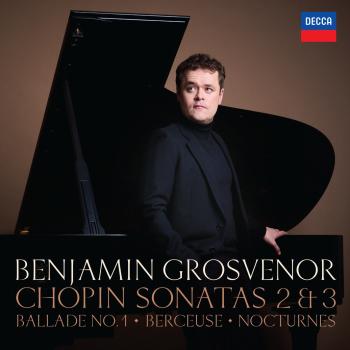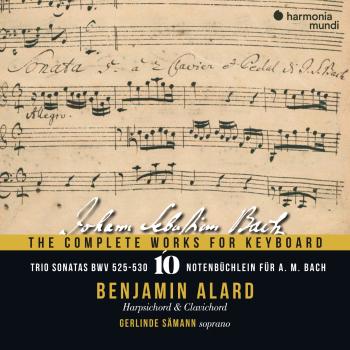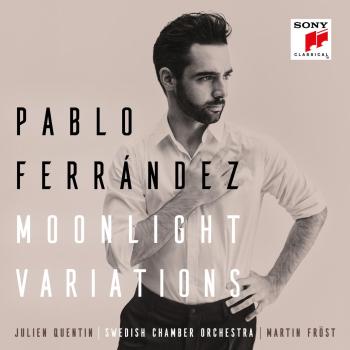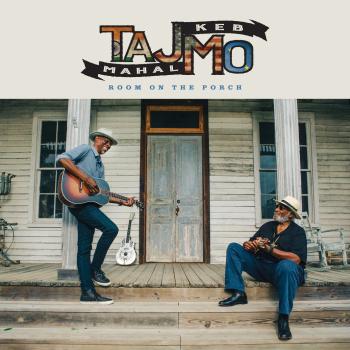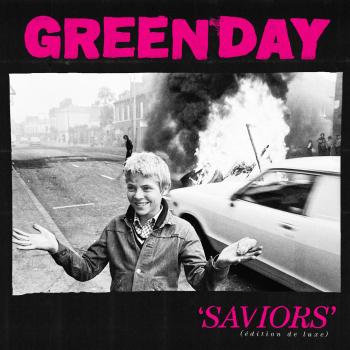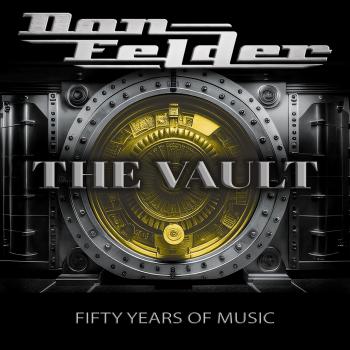
Concerto Veneziano Giuliano Carmignola & Venice Baroque Orchestra
Album Info
Album Veröffentlichung:
2004
HRA-Veröffentlichung:
26.11.2012
Label: Deutsche Grammophon (DG)
Genre: Classical
Subgenre: Concertos
Interpret: Giuliano Carmignola & Venice Baroque Orchestra
Komponist: Antonio Vivaldi (1678-1741), Pietro Antonio Locatelli (1695–1764), Giuseppe Tartini (1692-1770)
Das Album enthält Albumcover
Entschuldigen Sie bitte!
Sehr geehrter HIGHRESAUDIO Besucher,
leider kann das Album zurzeit aufgrund von Länder- und Lizenzbeschränkungen nicht gekauft werden oder uns liegt der offizielle Veröffentlichungstermin für Ihr Land noch nicht vor. Wir aktualisieren unsere Veröffentlichungstermine ein- bis zweimal die Woche. Bitte schauen Sie ab und zu mal wieder rein.
Wir empfehlen Ihnen das Album auf Ihre Merkliste zu setzen.
Wir bedanken uns für Ihr Verständnis und Ihre Geduld.
Ihr, HIGHRESAUDIO
- Concerto for Violin and Double Orchestra in B flat major, RV 583
- 1 1. Largo e spiccato - Allegro non molto 05:21
- Concerto for Violin, Strings (in due cori) and 2 Harpsichords in B flat Major, RV 583
- 2 2. Andante 04:02
- Concerto for Violin, Strings (in due cori) and 2 Harpsichords in B flat Major, RV 583
- 3 3. Allegro 04:34
- Concerto for Violin, Strings and Harpsichord in E minor, RV 278
- 4 1. Allegro molto 06:12
- Concerto for Violin, Strings and Harpsichord in E minor, RV 278
- 5 2. Largo 04:23
- Concerto for Violin, Strings and Harpsichord in E minor, RV 278
- 6 3. Allegro 04:18
- Violin Concerto Op.3, No.9
- 7 1. Allegro - Capriccio - Cadenza 07:28
- Violin Concerto Op.3, No.9
- 8 2. Largo 04:19
- Violin Concerto Op.3, No.9
- 9 3. Allegro - Capriccio - Allegro 07:04
- Violin Concerto in A, D.96
- 10 1. Allegro 05:19
- Violin Concerto in A, D.96
- 11 2. Adagio 03:37
- Violin Concerto in A, D.96
- 12 3. (Presto) 04:34
- Violin Concerto in A, D.96
- 13 4. Largo andante 04:41
Info zu Concerto Veneziano
'Dass Carmignola sich im barocken Repertoire zu Hause fühlt, merkt man bereits in den ersten Takten. Die langsame Einleitung zu Vivaldis Konzert für Violine und Streicher (»in due cori«) RV 583 wird von Carmignola in all seiner gestenreichen barocken Klangrede ausgekostet. Das folgende »Allegro non molto« wechselt mit kantablen Solopassagen ab, in denen Carmignola seine Violine zart singen lässt, ehe der Schwung des Ritornells lockere, flüssige Abwechslung bietet. Der langsame Satz, in seiner sanglichen, langgezogenen Melodielinie eine Seltenheit im frühen 18. Jahrhundert, wird zart interpretiert, sowohl vom Solisten als auch vom hervorragend begleitenden Venice Baroque Orchestra. Richtig stürmisch wird der Anfang von Vivaldis e-Moll-Konzert RV 278 genommen, ehe sich im »Largo« Solovioline, Streicher und Continuo (hier im Vordergrund: eine wunderschön und geschmackvoll gezupfte Laute) umranken. All diese Virtuosität erscheint bei Giuliano Carmignola nicht als Selbstzweck, sondern eingebunden in ein Spiel mit Figuren und hochexpressiven Passagen. Man hat bei jeder Note den Eindruck, dass Carmignola die rhetorischen Figuren barocker Musiksprache auch dem heutigen Hörer vermitteln kann. In der Interpretation gibt es keine leere Virtuosität, die den Musiker ins Zentrum rückte, sondern nur die Ausdruckskraft der Musik. Dies gilt vor allem auch für die Konzerte von Locatelli und Tartini, in denen das virtuose Element gegenüber den Konzerten von Vivaldi deutlicher hervortritt. Dass es Carmignola und dem glänzend musizierenden Venice Baroque Orchestra dennoch gelingt, alle Ausdrucksqualitäten dieser großartigen Konzerte auszuloten, verdient hohes Lob. Gute Klangbalance. Was das Ensemble unter vielen auf historischen Instrumenten musizierenden Formationen unterscheidet, ist eine exzellente Klangbalance, gepaart mit einem natürlich atmenden Tempo. Hier wird nicht sportiv durch die Werke gehetzt, sondern jedes Detail mit beherztem Schwung hörbar gemacht. Auch die Continuo-Gruppe agiert sehr differenziert. Besonders weich geriet hier der transparente Klang des Begleitensembles; die Streicher zeichnen sich durch eine betont zarte Klanggebung aus. In diesem Umfeld wirkt Carmignolas Virtuosität mit allen technischen Kniffen wie Springbogen, Doppelgriffe etc. wie ein aufrührerisches Element. Dass diese Produktion so kurzweilig wirkt, liegt sicherlich zum einen an dem ausdrucksstarken Spiel des Solisten, zum anderen an der Auswahl der Werke. Die Gegenüberstellung dreier Komponisten, die sich mit dem Solokonzert auf solch hinreißend unterhaltsame Art auseinander setzten, ist vollauf gelungen.' (Tobias Pfleger, Klassik.com)
Giuliano Carmignola, violin
Venice Baroque Orchestra
Andrea Marcon, conductor
In this recording Giuliano Carmignola plays a violin from 1739 by Floreno Guidantus, Bologna,
with a 'Tartini' (long) bow made in 2004 by Walter Barbiero.
Recorded at Manzano, Udine by Abbazia di Rosazzo, 5/2004
Giuliano Carmignola - Violinst
Born in Treviso, where the Vivaldi renaissance started 50 years ago, Giuliano Carmignola began his violin studies with his father. His first teacher at the Venice Conservatory, Luigi Ferro, was a soloist with the Scuola Veneziana Orchestra (created in 1947 by Angelo Ephrikian to perform Vivaldi’s music) and later played with the Virtuosi di Roma, with whom Carmignola was in turn to appear as a soloist from 1970 to 1978, while succeeding Ferro as a teacher in Venice. Carmignola’s career was launched at the beginning of the 1970s with his successes in national and international competitions. Having attended master classes with Nathan Milstein, Franco Gulli and Henryk Szeryng, he went on to perform the major violin works of the 19th and 20th centuries under conductors of the stature of Claudio Abbado, Eliahu Inbal, Peter Maag and Giuseppe Sinopoli, in-cluding giving the Italian premiere of Henri Dutilleux’s Violin Concerto.
As a teacher, Carmignola has been on the staff of the Musikhochschule in Lucerne and the Accade-mia Musicale Chigiana in Siena. His distinctions include the title of Accademico of the Reale Acca-demia Filarmonica in Bologna and the Accademia di Santa Cecilia in Rome. Giuliano Carmignola plays the “Baillot” Stradivari (1732), presented to him by the Fondazione Cassa di Risparmio in Bologna for his artistic achievements and his commitment to that city’s Orchestra Mozart.
Andrea Marcon - Conductor
The Venice Baroque Orchestra’s founder and director, Andrea Marcon, was born in Treviso in 1963 and received a diploma in early music from Basle’s Schola Cantorum for his organ and harpsichord studies with Jean-Claude Zehnder. Among his other influential teachers were Luigi Ferdinando Tagliavini, Hans van Nieuwkoop, Jesper Christensen, Harald Vogel and Ton Koopman. From 1983 to 1997, he was harpsichordist and organist of the Treviso-based early music ensemble Sonatori de la Gioiosa Marca. He also founded and directed the International Organ Festival “Città di Treviso”, playing a prominent role in the restoration of the city’s historic organs. He is a professor of harpsichord, organ and interpretation at the Schola Cantorum Basiliensis (since 1997), and has also been visiting professor at the Sweelinck Conservatory in Amsterdam.
Venice Baroque Orchestra
Founded in 1997 by Baroque scholar and harpsichordist Andrea Marcon, the Venice Baroque Orchestra is recognized as one of the premier ensembles devoted to period instrument performance. The Orchestra has received wide critical acclaim for its concert and opera performances throughout North America, Europe, South America, Japan and Korea.
Highlights of the 2011/12 season included the opening of the Bruge Concertgebouw season with Vivaldi’s Stabat Mater and Gloria; concerts in Lisbon and France with soprano Patricia Petibon; concert performances of their pasticcio of Metastasio’s L’Olimpiade in London, Dijon, Brussels, Paris, Athens, Rome and Siena, performances with violinist Giuliano Carmignola at the Enescu Festival, the Gstaad and Dubrovnik festivals, and in Geneva and Fénétrange; and concerts in Italy and Russia with mezzo-soprano Romina Basso and with Simone Kermes in Poland, as well as performances of Baroque multi-instrument concertos throughout Europe.
The 2010/11 season featured a 28-city tour of the United States with violinist Robert McDuffie in premiere performances of Philip Glass’s new violin concerto, The American Four Seasons; a tour of Japan and Korea with violinist Giuliano Carmignola; concerts in Austria and France with soprano Patricia Petibon; Vivaldi’s La senna festeggiante performed in Amsterdam’s Concertgebouw; Baroque cello concertos with Gautier Capuçon in Germany; Pergolesi’s Stabat Mater at Théâtre des Champs Elysées with soprano Veronica Cangemi and contralto Sara Mingardo; a US tour with violinists Giuliano Carmignola and Giulio Plotino; Vivaldi arias with Romina Basso in Amsterdam’s Concertgebouw, Monteverdi’s Vespers in Leipzig, and a tour of summer festivals in Austria, Germany, and Switzerland featuring mezzo-soprano Magdalena Kožená. In recent seasons, the Orchestra has also performed with
Cecilia Bartoli, Anna Netrebko, Vivica Genaux, Andreas Scholl, Marie-Nicole Lemieux, Roberta Invernizzi, Simone Kermes and Viktoria Mullova.
Dieses Album enthält kein Booklet

